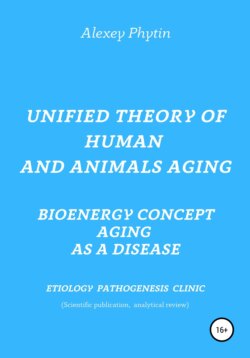Читать книгу Unified theory of human and animals aging. Bioenergy concept aging as a disease - Алексей Фёдорович Фитин - Страница 4
1. Part One
1.2. The Pathogenesis of Aging
ОглавлениеThis section discusses the sequence of events connected by a network of cause-and-effect relationships and representing the pathogenesis of the disease of aging: – hypoxia; – decrease in the rate of formation of free energy carriers (ATP and NAD(P)H); – degeneration of sensitive nerve endings of the ANS; – irreversible activation of the efferent part of the arc of the unconditioned reflex; – depletion and degeneration of the efferent part of the arc of the unconditioned reflex; – switching the regulation of cellular metabolism and adaptation from the ANS to a less efficient and slow-acting endocrine system; – loss of differentiated properties by the cells of the denervated periphery and the acquisition of the properties of undifferentiated cells – the ability to proliferate and migrate.
In local areas of organs, tissues or blood vessels, the listed stages of pathogenesis are at different stages of development, and therefore, in each organ or tissue, all stages of the pathogenesis of aging are simultaneously implemented. The main pathological consequences of each of the listed stages of pathogenesis and their manifestations in proliferative-degenerative diseases of senile age are considered.
Hypoxia initiates two independent primary structural events.
1) Death of free living cells by apoptosis or necrosis (see above). 2) Degeneration and slowing down of regeneration of afferent nerve fibers of the autonomic nervous system (ANS).
The sympathetic division of the ANS is responsible for stimulating the metabolism of activity (catabolism) associated with the fight-or-flight response. The parasympathetic division of the ANS is responsible for stimulating resting metabolism (anabolism): “rest and digestion” and “feeding and reproduction”.
Afferent fibers are not divided into sympathetic and parasympathetic.
Metabolism at rest is less intense than in a state of physical activity, since the main consumer of free energy is skeletal muscles that are inactive at rest.
The state of activity is characterized by sharp ups and downs of metabolic activity, in contrast to the slow monotonic changes in metabolism in a state of rest. It is in connection with these differences that the degeneration of afferent fibers in the first place negatively affects the efficiency of the functioning of the sympathetic rather than the parasympathetic division of the ANS.
The weak link in autonomic regulation is the afferent, sensitive nerve fibers, each of which departs from a small group of cells or from single specialized receptors (bodies). A decrease, for one reason or another, in the number of cells in such a group or in a specialized receptor innervated by a separate axon leads to an increasingly rare use of the nerve fiber and, as a result, to its degeneration.
The most common cause of degeneration of afferent nerve fibers, apparently, is the death of nerve endings under conditions of deep and/or prolonged hypoxia. Nerve endings are the most distant from the neuron body and oxygen deficiency, leading to a deficiency of free energy, should primarily affect the delivery of nutrients and “building materials” necessary to maintain the integrity of nerve endings and for their regeneration, namely in the nerve endings.
Such degeneration of nerve endings belongs to the physiological category, in contrast to pathological degeneration caused by a violation of the integrity of nerve fibers as a result of injury or inflammation.
Afferent nerve fibers carry out negative feedback in the arc of an unconditioned reflex, turning off the activating effect of efferent fibers on innervated cells.
Due to the presence of a second, nonspecific afferent system of the ANS, the afferent innervation performs not only the passive function of switching off (inhibition) of the efferent part of the unconditioned reflex arc, but also an active function – inhibition of the central structures of the ANS. This function is provided by pacemakers in each small group of cells from which a single nerve fiber originates. Apparently, most of the time, it is the afferent fibers of the ANS that function, supporting with their signaling through the second, nonspecific afferent system, the inhibited state of the cells of the nuclei of the brain stem (including the hypothalamus).
